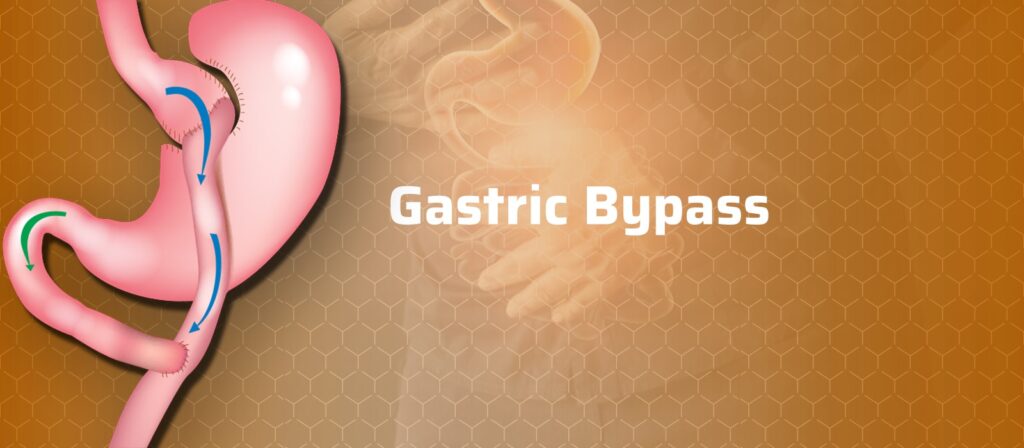What is Gastric Bypass Surgery?
Gastric bypass surgery is a type of bariatric bypass surgery that reduces the size of the stomach and changes the digestive pathway to promote weight loss. By creating a small stomach pouch and rerouting the small intestine, this gastric bypass procedure restricts the amount of food consumed and limits calorie absorption. Gastric bypass is particularly effective for individuals with a high BMI or obesity-related health conditions who haven’t had success with other weight loss methods.

There Are Two Types of Gastric Bypass:
Roux-en-Y Gastric Bypass
The Roux-en-Y gastric bypass is the more commonly performed and traditional form of gastric bypass operation. In this procedure, the surgeon creates a small pouch at the top of the stomach and connects it directly to the small intestine. This reduces the stomach’s capacity and bypasses a portion of the intestines, limiting calorie absorption.
Single Anastomosis or ‘Mini’ Gastric Bypass
The mini gastric bypass, also known as the single anastomosis gastric bypass, is a simpler alternative to Roux-en-Y. This version requires only one connection between the stomach and intestines, which can reduce surgical time and recovery. While the mini gastric bypass is gaining popularity, it may not be suitable for everyone. Consulting with experienced gastric bypass doctors will help determine the best approach.
What Are the Benefits of Bariatric Gastric Bypass Surgery?
The gastric bypass offers multiple health benefits:
- Significant weight loss: Patients typically lose 60-80% of their excess weight within the first two years.
- Improvement in obesity-related conditions: Many patients see improvements in diabetes, high blood pressure, and sleep apnea.
- Long-term weight maintenance: With lifestyle changes, gastric bypass can lead to sustained weight loss.
- Enhanced quality of life: Increased energy levels and improved mobility are common among patients who undergo bariatric bypass.
When Might I Consider Gastric Bypass Surgery?
Gastric bypass surgery is recommended for individuals with:
- A BMI of 40 or more, or 35+ with obesity-related conditions
- Severe health issues related to obesity, like type 2 diabetes or heart disease
- A history of unsuccessful weight loss attempts through non-surgical methods
If you’ve had a gastric bypass sleeve or sleeve bypass and experienced weight regain, you may be a candidate for a gastric bypass revision or Roux-en-Y revision to improve your results.
How Do I Prepare for Gastric Bypass Surgery?
To prepare for gastric bypass, patients will undergo medical evaluations and lifestyle adjustments:
- Preoperative assessments: Routine blood tests, imaging, and consultations with healthcare providers.
- Nutritional counseling: Learning about dietary changes before and after surgery.
- Lifestyle modifications: Quitting smoking, adjusting medication, and following a preoperative diet can all improve surgical outcomes.
Your doctor will discuss the gastric bypass cost and insurance options, as well as potential financial arrangements if required.
What Should I Expect During Gastric Bypass Surgery?
The gastric bypass operation is typically performed laparoscopically, using small incisions to minimize invasiveness. Patients are under general anesthesia during this two- to three-hour procedure, and most patients can expect a hospital stay of one to three days following surgery.
What Can I Expect After the Gastric Bypass Procedure?
After the gastric bypass procedure, patients follow a structured recovery plan:
- Initial dietary adjustments: Beginning with a liquid diet, followed by pureed foods, and gradually transitioning to solid foods over several weeks.
- Activity and exercise: Light activity is encouraged soon after surgery, with increased exercise as recovery progresses.
- Long-term dietary and lifestyle changes: To maintain weight loss, patients are encouraged to prioritize protein intake, eat smaller portions, and avoid high-calorie foods.
Many people report noticeable weight loss within the first few months and a decrease in hunger due to hormonal changes resulting from the surgery.
What Are the Risks of Gastric Bypass Surgery?
While different bariatric surgeries carry some degree of risk, gastric bypass has certain specific considerations:
- Surgical risks: Infection, bleeding, or reaction to anesthesia.
- Nutritional deficiencies: Reduced nutrient absorption can lead to deficiencies in vitamins and minerals, requiring lifelong supplements.
- Dumping syndrome: Rapid food passage can cause symptoms like nausea, dizziness, and diarrhea.
- Potential need for revision: Some patients may require a gastric bypass revision if they experience insufficient weight loss or weight regain.
Your surgeon will discuss these risks with you to ensure a well-informed decision.
Frequently Asked Questions About Gastric Bypass
How Safe is Gastric Bypass?
Gastric bypass surgery is generally safe, with improved techniques and careful patient screening. The risk of complications varies depending on individual health, and an experienced surgical team can minimize risks.
Is Gastric Bypass Permanent?
Yes, gastric bypass is intended as a permanent procedure. While it can be revised in certain cases, it is typically not reversible.
How Quickly Do You Lose Weight After Gastric Bypass?
Most patients experience rapid weight loss within the first six to twelve months, with many losing up to 60-80% of their excess body weight within two years.
Is Gastric Bypass Surgery Right for Me?
Gastric bypass is suitable for individuals who have tried other weight loss methods without success and meet the recommended BMI or health criteria. Consulting with a gastric bypass doctor is the best way to evaluate your options, including understanding the gastric bypass price and benefits relative to other types of gastric bypass or gastroplasty.
Explore Your Options for Bariatric Surgery
To learn more about how much gastric bypass costs or if gastric bypass after sleeve surgery is right for you, connect with experienced gastric bypass doctors who can guide you through the process and ensure a safe, effective journey toward weight loss and improved health.
